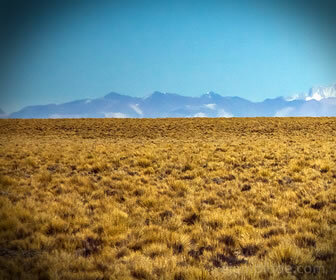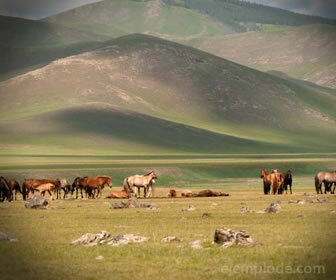Characteristics Of The Steppe
Biology / / July 04, 2021
The steppe it's a biome characterized by large grass plains. Also it is known as plain or pampa. They are found in both the northern and southern hemispheres and They are characterized by being grasslands, reddish earth and temperate-cold, arid and dry climate. The steppes are located in Russia, Mongolia, North America, northern Mexico, Chile, Uruguay, Argentina, and southern Brazil. It is a biome close to the taigas and the Chaparrales. There are small extensions of steppes in Europe, located in northern Italy and the Almería region in Spain.
List of characteristics of the Steppe
- Reddish soils
- Little water
- Semi-desert
- Small plants and grasses grow
- Little variation in relief
- Arid and cold climate
- Little rain
- Few animals, herbivores.
- Land with mineral wealth
General characteristics:
The Steppe are ecosystems in which the soils are reddish, due to the presence of iron oxide, Although they are also lands rich in minerals, the little amount of available water only allows them to grow pastures. They form extensions with few variations in their relief, being considered as a whole as flat plains. There are few animals, most of them herbivores. The climate is rather arid and cold, with very little rain during the year. The earth is rich in minerals, but poor in organic matter, so only small plants adapted to the little availability of water grow.
Steppe climate:
As we already mentioned, its temperatures range from -10 ° C in winter, to 25 degrees Celsius in the summer, with an average temperature of 10 to 15 ° C located in a cold temperate climate. These extensions are found in the interior areas of the continents, generally delimited by mountain systems that prevent access to the clouds. The little availability of water makes them look like semi-desert extensions, however, under the ground the Plant roots seek water and stay warm from extreme temperatures and conditions of the surface.

Flora:
The characteristic flora of this biome are xerophilic plants, which are adapted to the low availability of water. Among them, the pastures stand out. They can be small pastures, in the poorest lands, up to tall grasses in the most humid areas; Other types of plants that grow in the meadows are some aromatic plants like wormwood, some grasses like beans and small bushes and plants with tubers. It is also a suitable terrain for the growth of some cereals such as wheat or barley, due to its mineral wealth.
Fauna:
The fauna of the steppes is mainly herbivorous animals: horses, bison, antelopes, puppies of the prairie, moles, rabbits hares, rodents such as mice and shrews, moles, running birds, partridges and quail Among the predators, the coyote, some wolves, snakes and especially birds of prey such as eagles, hawks and owls stand out. There are also a wide variety of insects.
Characteristics of the main types of steppes
Pampas
Also known as steppes or humid meadows, they are regions with a steppe climate, with greater amounts of humidity (more than 1000 mm per year) and are characterized by tall grasses. The Pampa region extends through part of Bolivia, Argentina, all of Uruguay and the extreme south of Brazil. In addition to grasses, it is also conducive to grasses and scattered, ombúes grow. The Ombú is a plant that can reach up to 15 meters in height, but the characteristics of its trunk and branches correspond to the classification of giant grass and not a tree. In addition to this, the land lends itself to the sowing of crops such as wheat, which has been done intensively. As for the fauna, its natural fauna is made up of rodents, hares, partridges, pigeons, deer and wild boars. Cougars and foxes are the main predators. Sheep (sheep and goats), cattle (cows) and horses (horses), introduced since the times of the conquest and the colony, have also spread in these areas.

Russian-Mongolian steppe
Also known as the Asian steppe, it is located between Russia and Mongolia. They are large plains with short grasses, with a very arid climate. Wild horses, antelopes, marmots, mole rat, quail, cranes, and the Russian tortoise are very common in the steppe. One of the main predators is the eagle of the steppes.
American Prairie
The prairie located in North America, which spans from southern Canada to northern Mexico, has a less cold than the Russian steppe, although it is very similar to this one since short grasses also predominate as the main vegetation. The dominant fauna are bison, prairie dogs, roadrunners, moles, rodents, as well as horses introduced by man.
